July 17, 2016
Martha O'Kennon
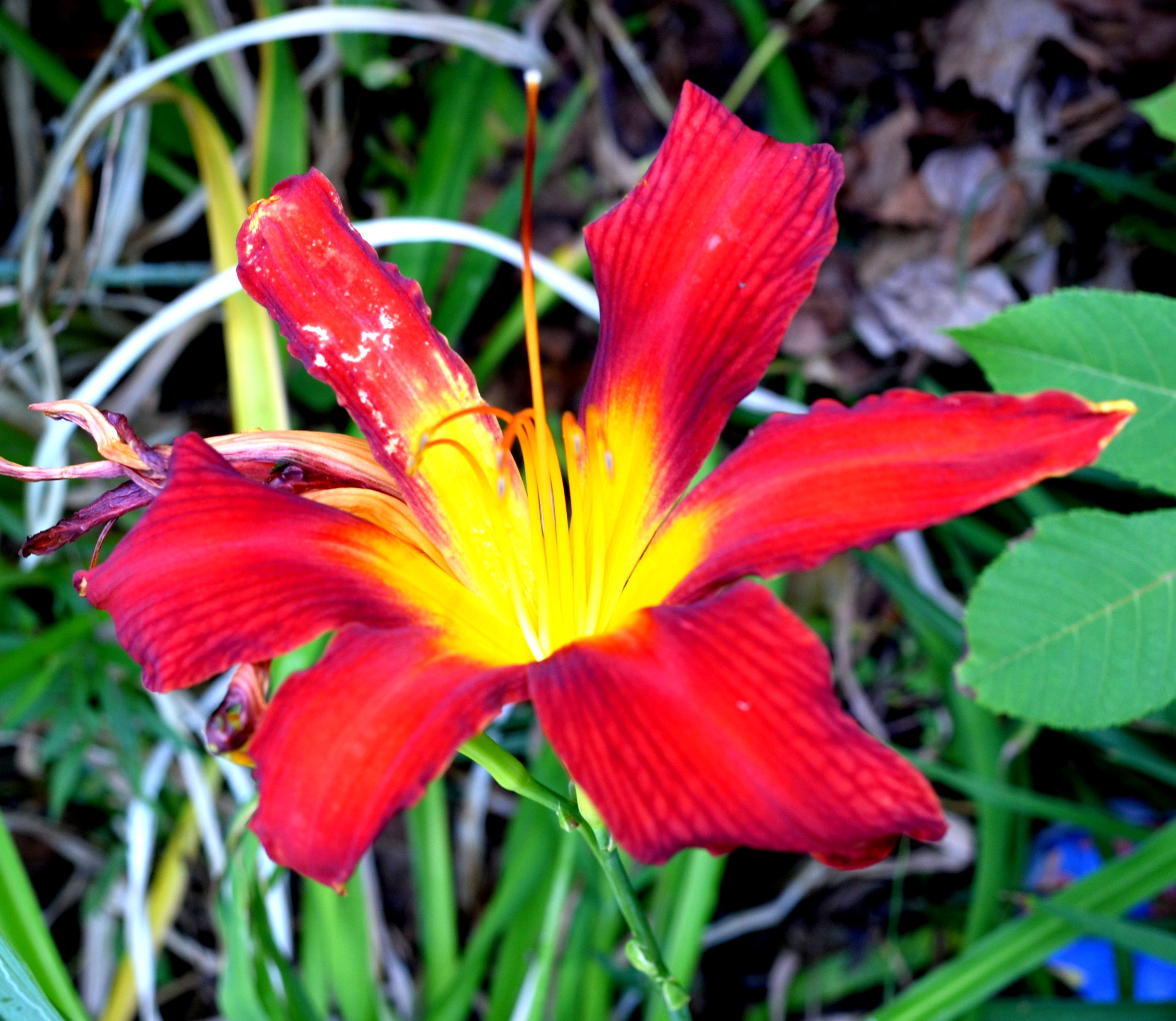

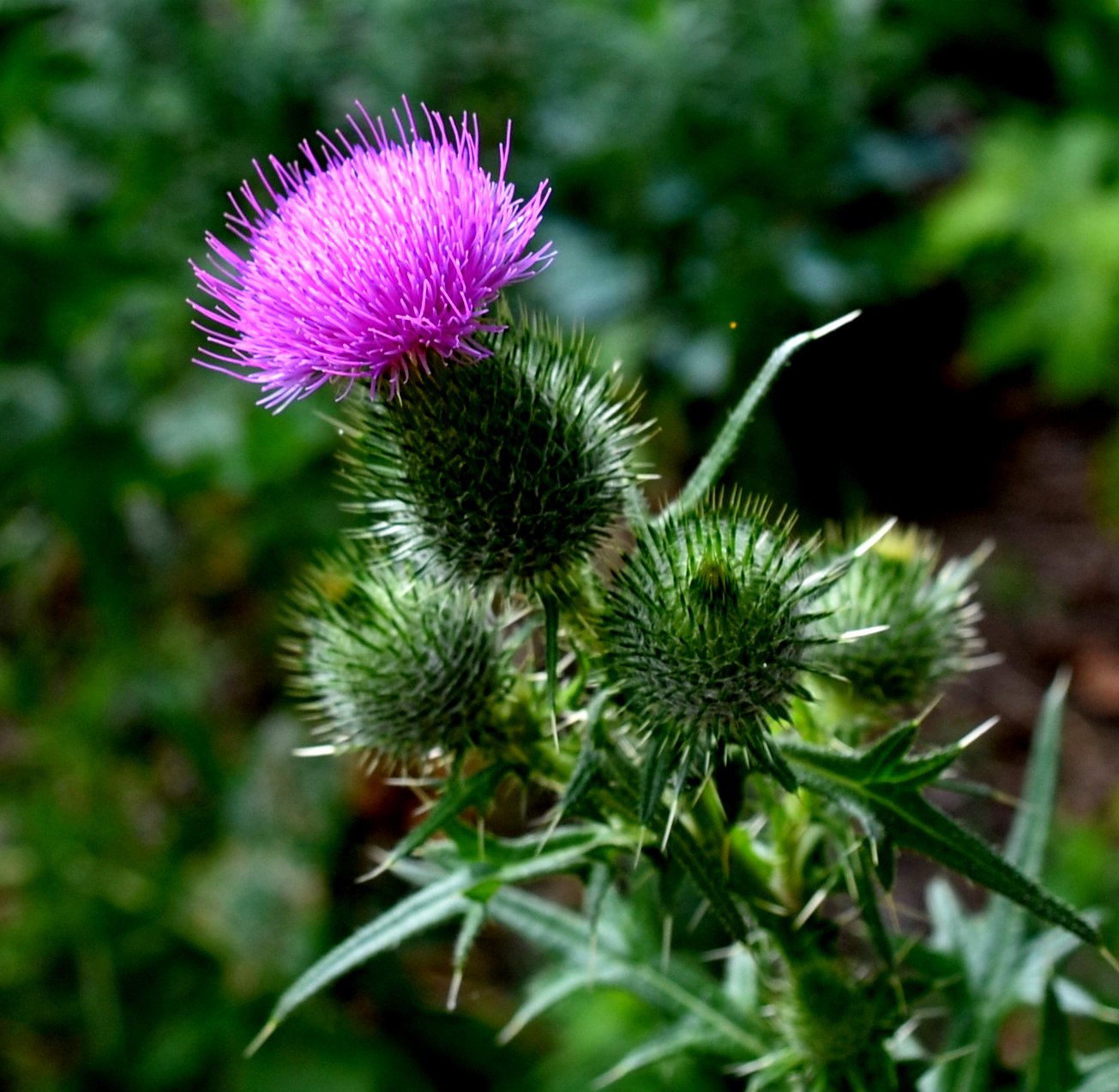
There are many signs that the summer is about half-shot. The deep pink phlox is in full bloom; the thistles are just starting to bloom (Each plant has one bloom); the balloon flowers had two blooms yesterday. The big red long-petaled daylily on the left - I hadn't ever noted when it bloomed (if it bloomed at all). So it is there just for its beauty.
Remember that there is information in the name of the file for each image. You can see it by mousing over the image - look at the lower left of the screen.
I would try clicking on the image. If the little "+" sign appears, it means you can enlarge again. While it is in "+" mode, click on something you want to see more clearly and it will zoom to that section. Then the info is displayed in the address line above. If the image has been cropped
so that clicking on it doesn't result in a larger picture, you can always hit control-plus to increase the size of the image.
This Carpenter or Sugar Ant is so shiny I believe you might be able to catch a glimpse of the camera in the abdomen. Among the aphids you can now easily find little black ones or even fluffy white ones. Fluffy here is either a wooly aphid or a gall aphid. It takes a while to find one that has an eye and a few legs showing.
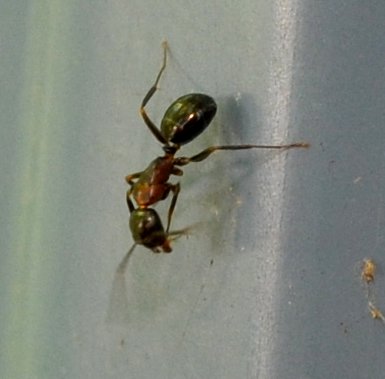
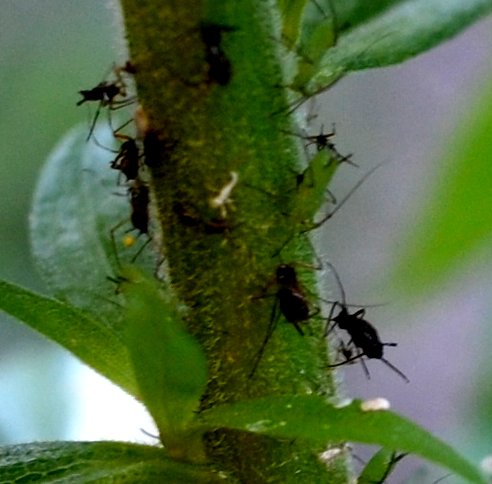
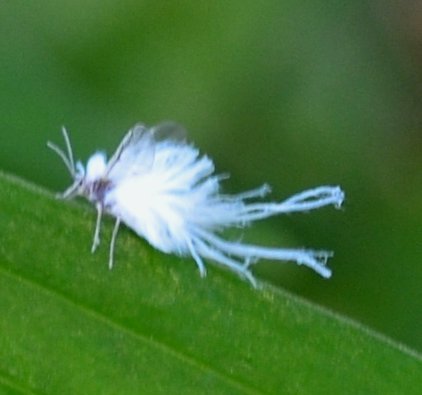
This pretty thing is the barklouse Graphopsocus cruciatus, one of my favorites. I don't know why the bees try so hard to get nectar from the largely unopened blooms of the trumpetvine, but here it is anyway - a green sweat bee. The honey bee is similarly attracted to the overwhelmingly colorful but closed flowers.
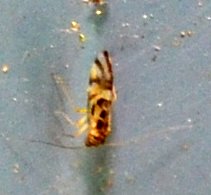 .
.
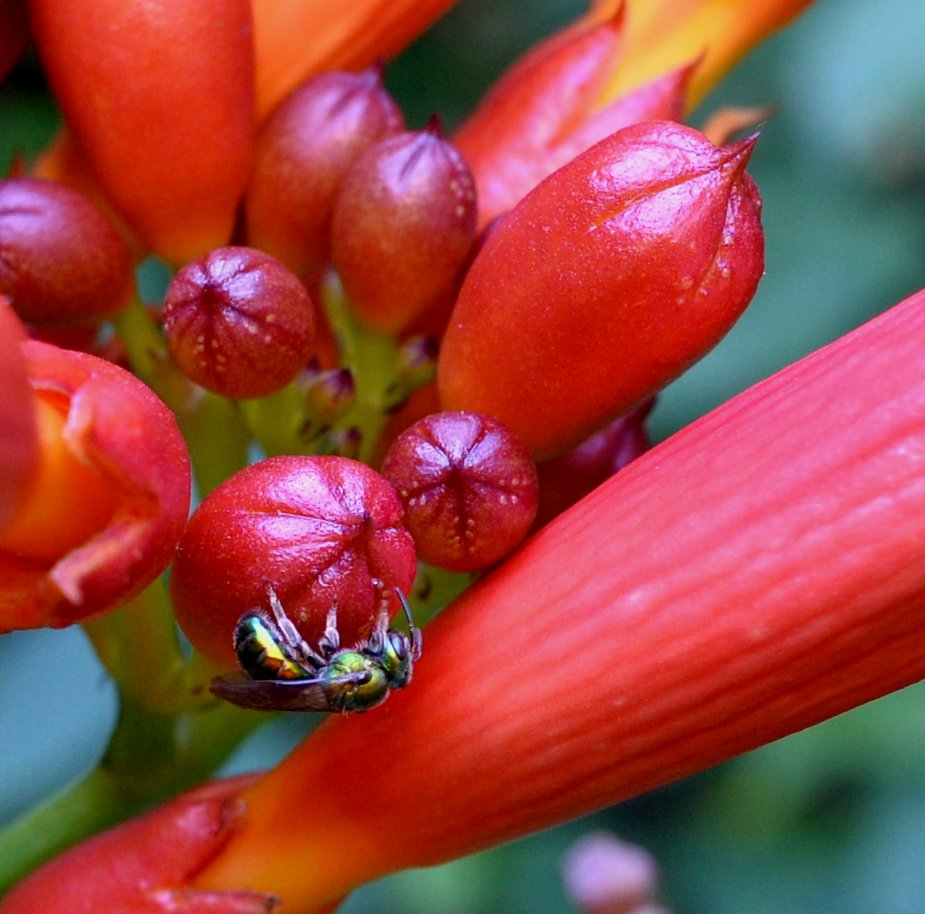
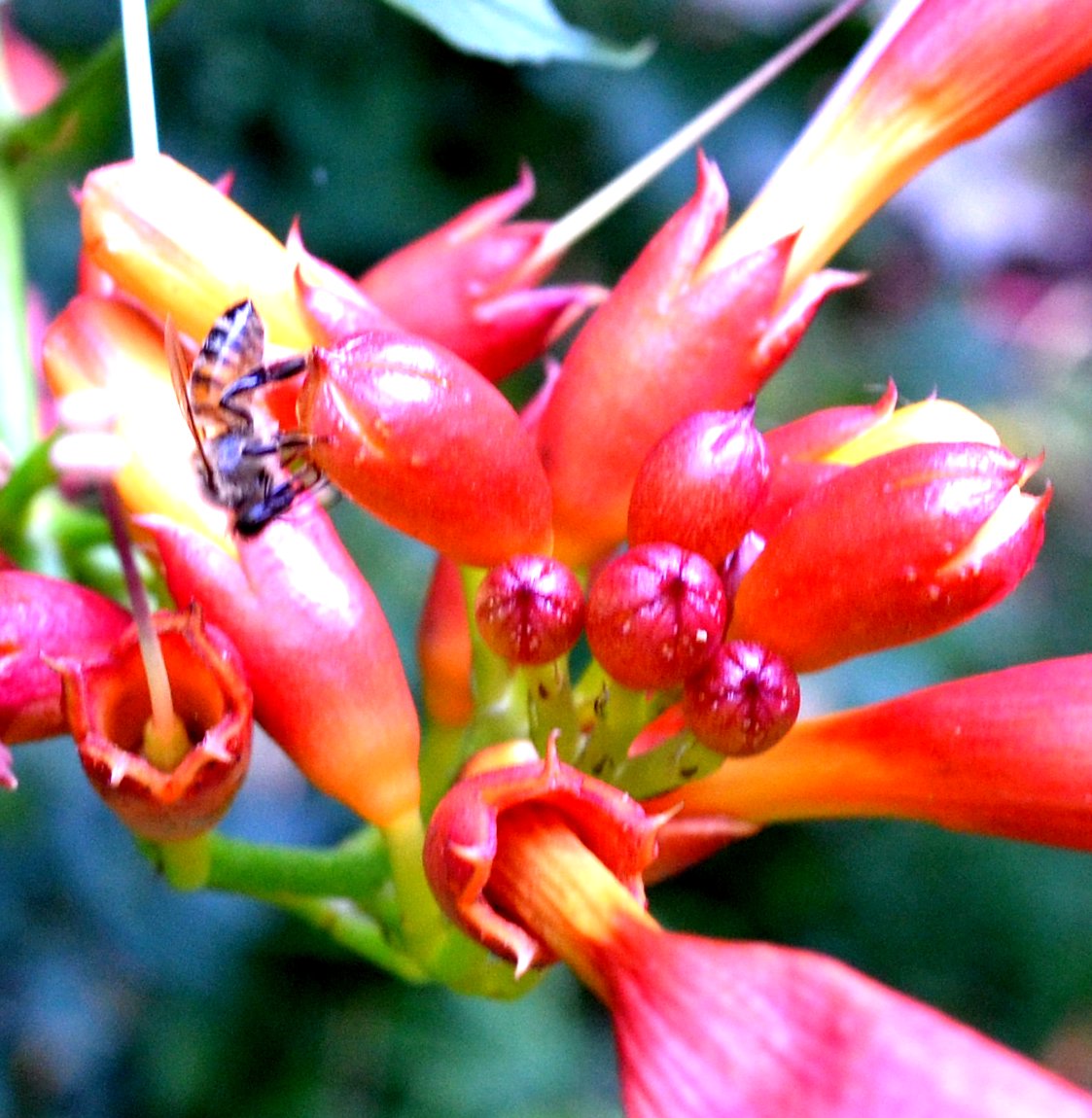
Finally, on thistle flowers, what seems from its golden underbelly to be a mason bee, and another bee that I haven't been able to identify yet.

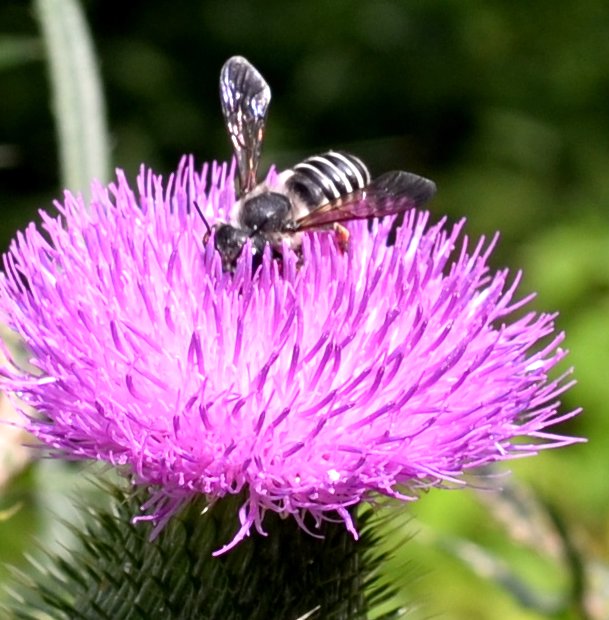
This ladybird with no spots but a hefty coat of shellac is called the Polished Lady Beetle. We also had a couple of weevils, one pale bluish-greenish one, and one shiny one.
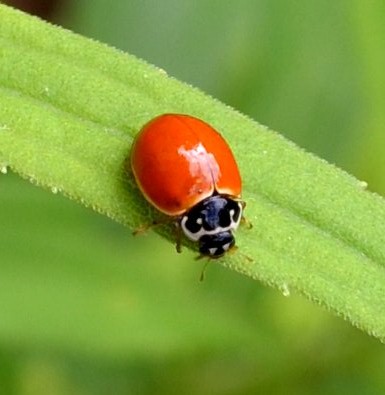 .
.
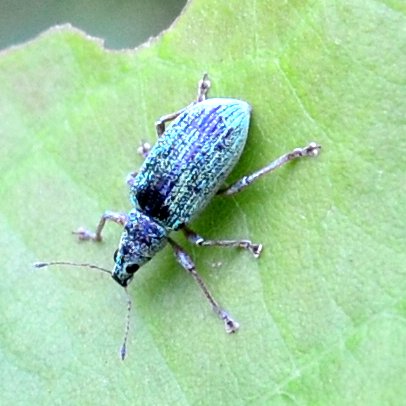
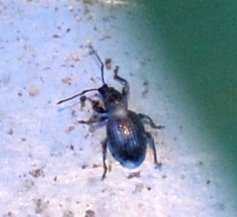
Here we have a black beetle, the usual ladybird, and another shiny tiny beetle.
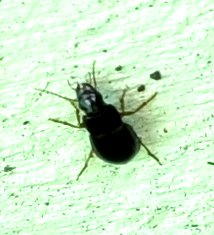
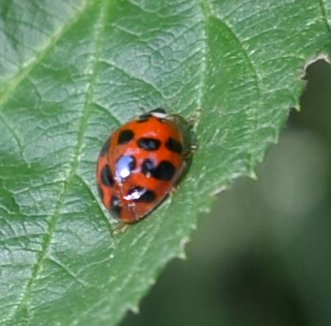
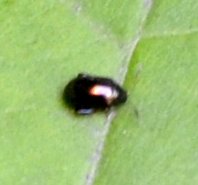
You probably don't need to see yet another Japanese Beetle, but thought you might like to see its skill in making drawn-work lace out of an oak leaf. Now for the bugs. Here is the adult Assassin Bug, upside down under a leaf. And here's the next installment of what used to be the bug in a blue tutu..


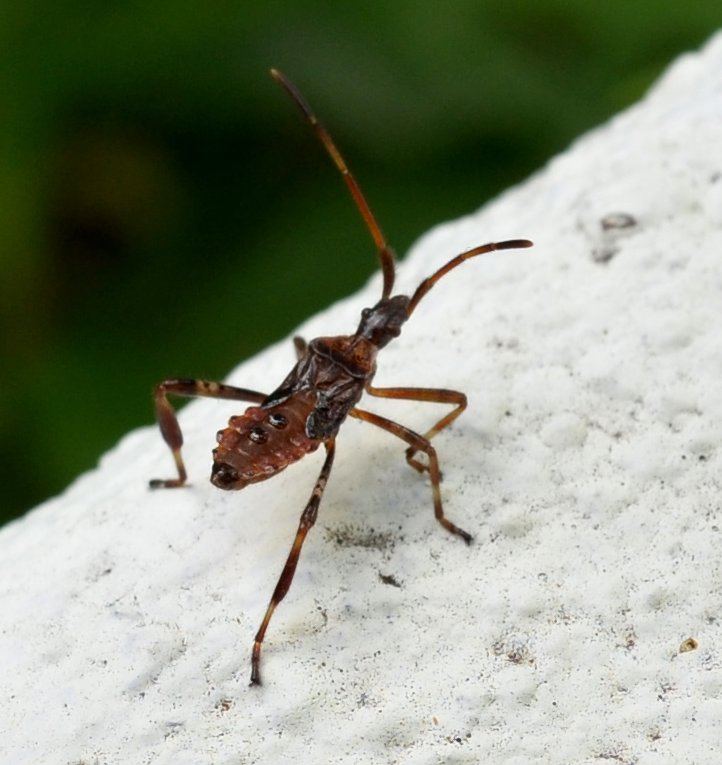
The leafhoppers were once more plentiful. Here's the Aphrodes leafhopper female. Mr. Aphrodes is long gone, who knows where. Here's a new kind, unfortunately not the best shot in the world, but looks like one of the Scaphoideus. And another that seems to be wearing a torn-up skirt of leaves and grass. This latter barklouse looks like Echmepteryx hageni.
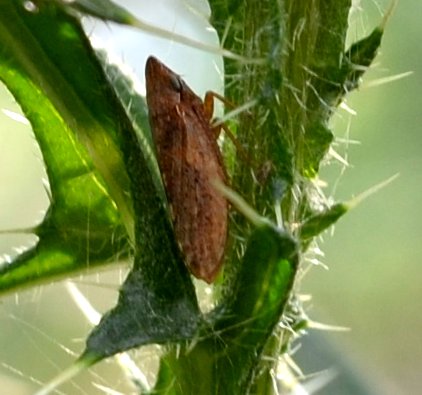
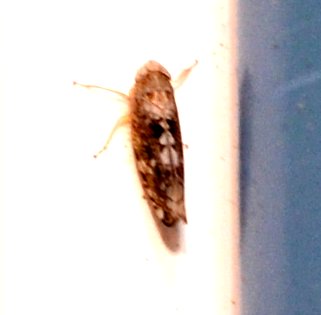
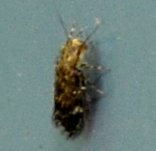
Here's an old favorite, the "flower print" leafhopper; a gorgeous blue checked one; and a greyish one with a very subtle pattern.
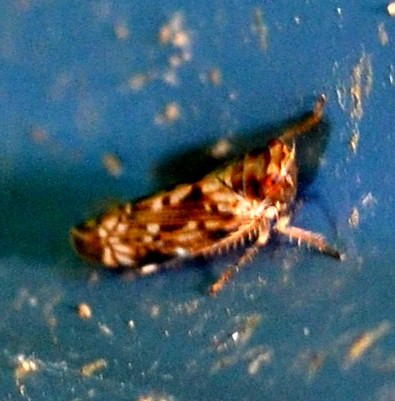
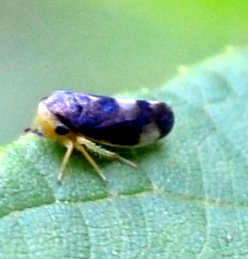
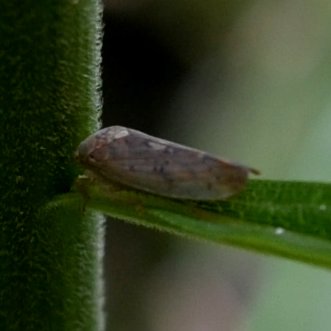
One more adult leafhopper, so far unnamed. Now for some young ones, nymphs of leafhoppers: the Coelidia olitoria nymph with the curled-up tail and what is NOT the nymph of a candy-striper, but that of a Planthopper called Thionia bullata. Now we can clearly see that its tail is a mass of tiny filaments.


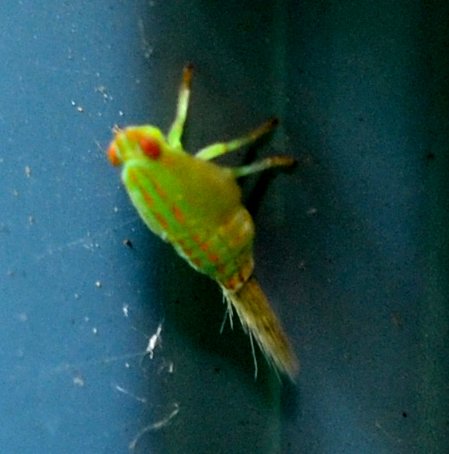
If you remember, a while ago we showed a picture of a bug nymph that mimicked an ant. This is another one. I love the way its joints seem to have been made like a robotic ant. And this spittlebug resembling an Alder Spittlebug is predominantly black and white instead of brown and white. We'll find out soon that it is a male and the browner ones are females. This buffalo treehopper is the first one I've seen this year.
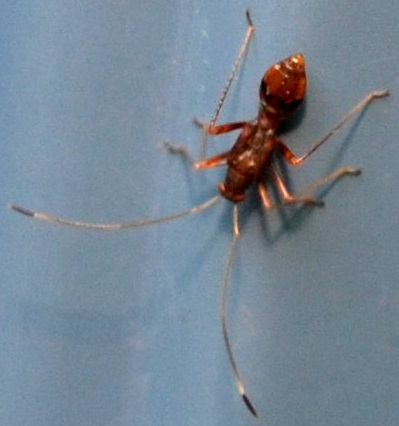
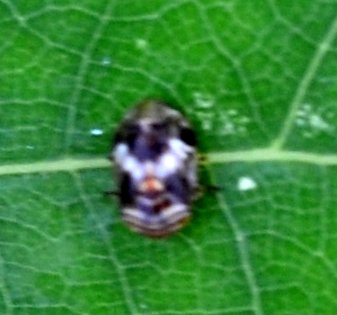
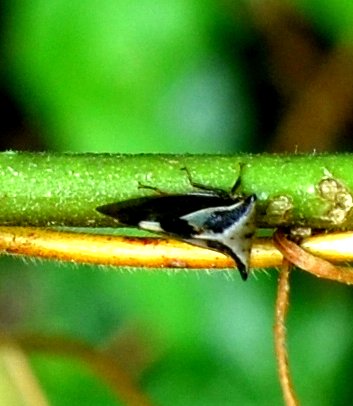
Speaking of treehoppers, Entylia carinata (the camel-shaped treehopper) is getting its foodhold in one of the thistle plants, and Enchopa on-cercis, the two-mark treehopper on redbud, has made it to the weeping redbud in the front garden.
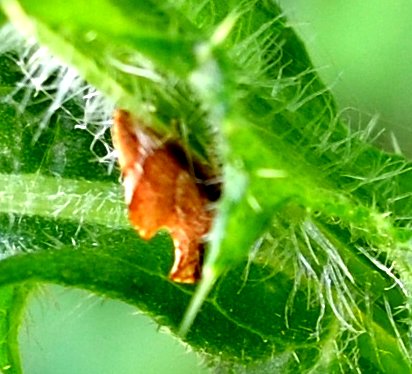
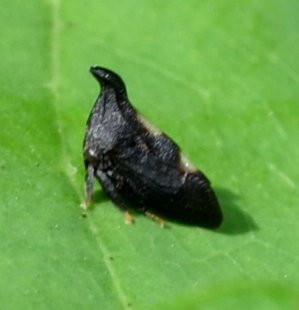
Under butterflies and moths, this battered butterfly is probably the Banded Hairstreak. I believe we've seen this little moth before. But this big moth, about 2 inches from top to bottom, is the Leopard Moth. Miya Dunham-Weber found it for me. Finally, this Autumn Meadowhawk sat down in front of me to manage to get the legs of its prey politely inside its mouth.
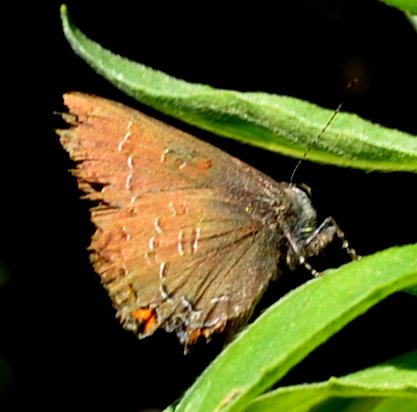

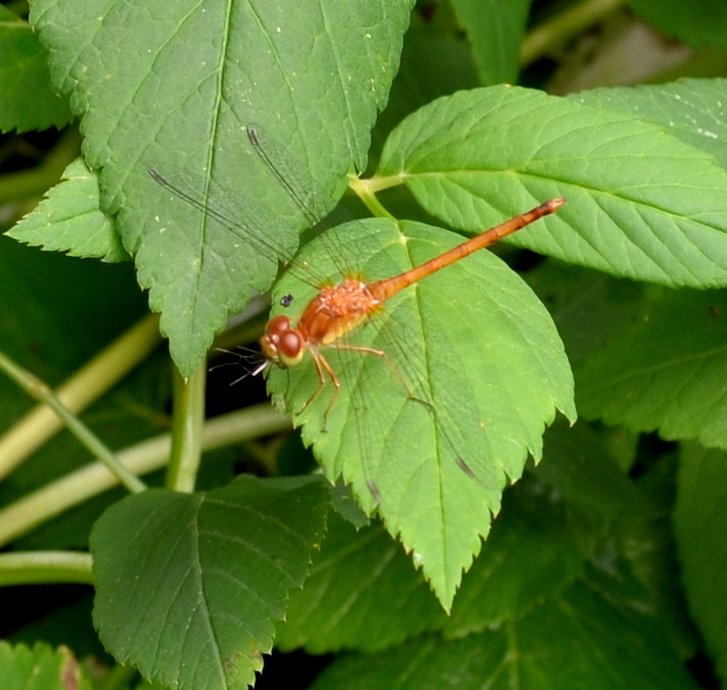
These four crane flies made cameo appearances in the yard this week.
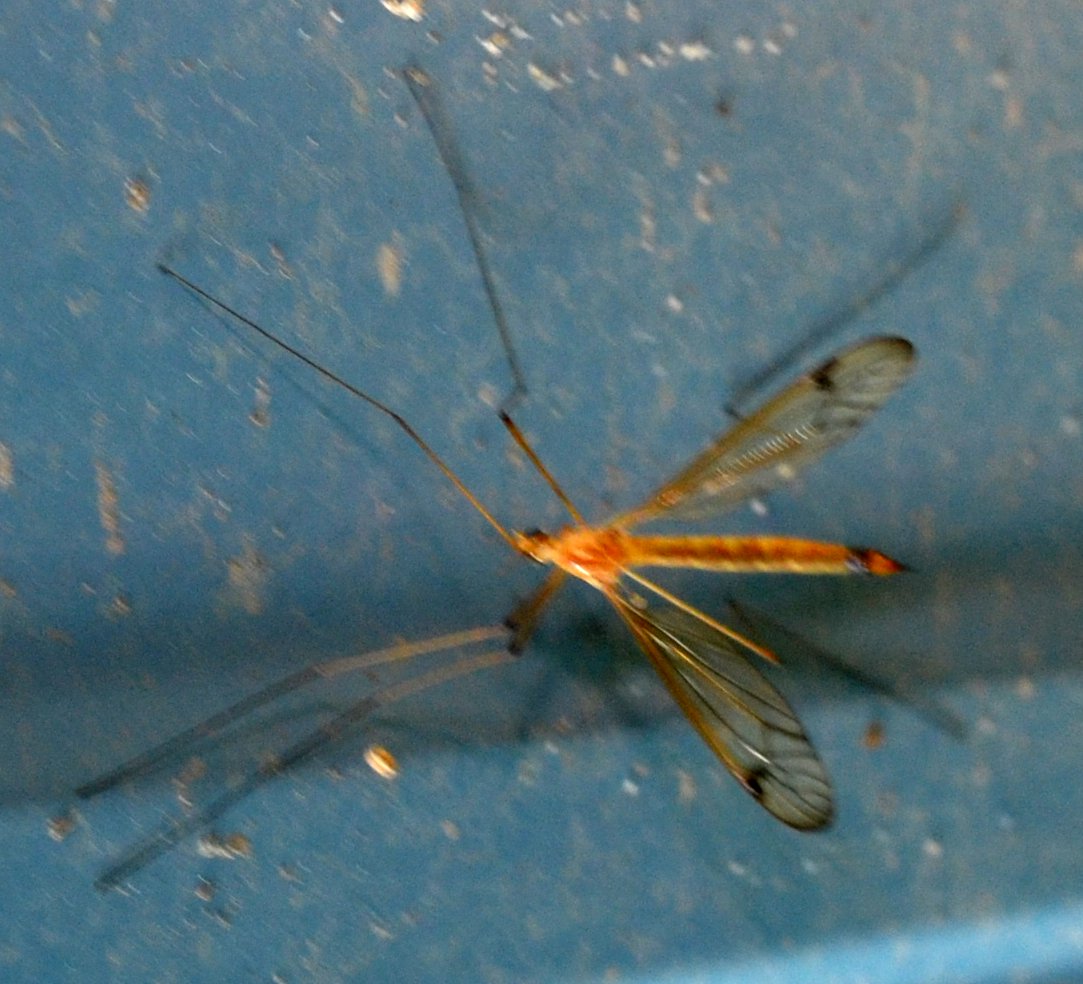
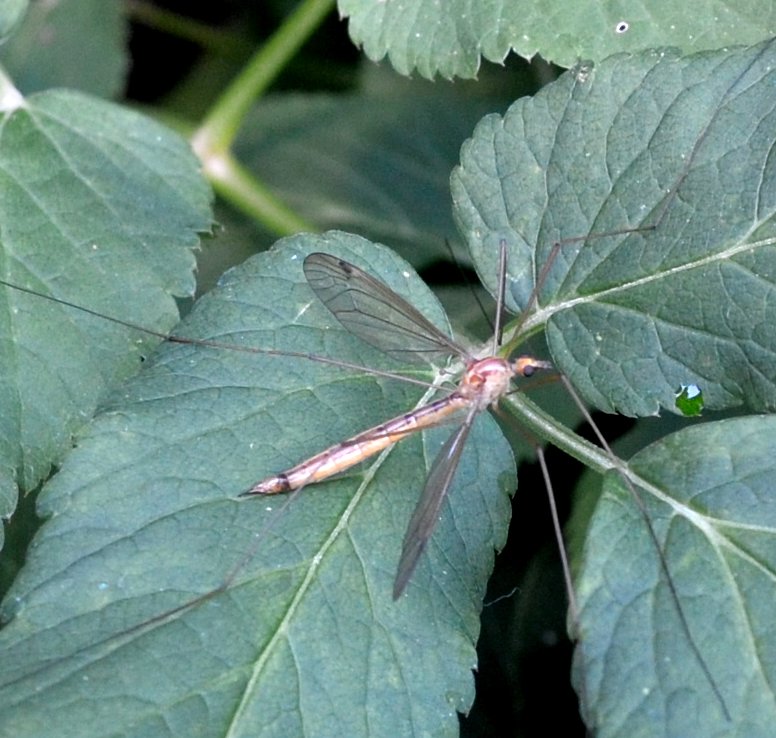

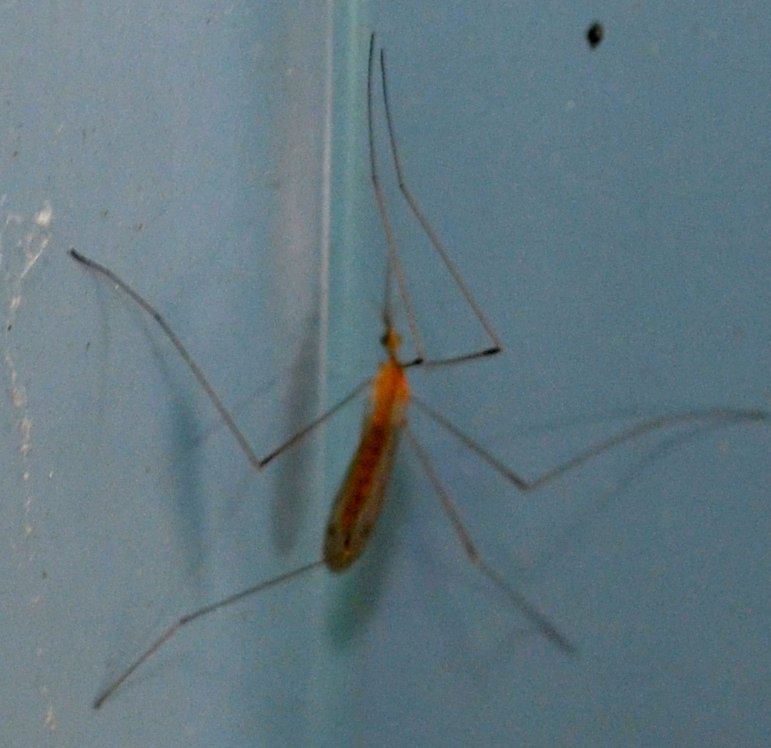
I don't know what this first big fat fly is. I had thought the next one was a dark-winged fungus gnat, but Bugguide told me it was more likely a gall midge. This old friendly hover fly was the only one I saw this week.
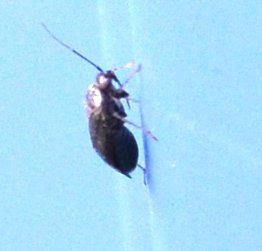
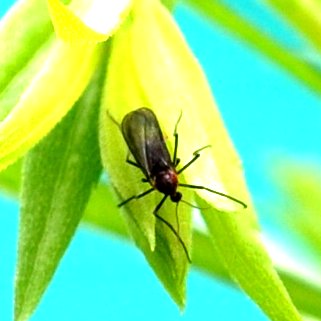
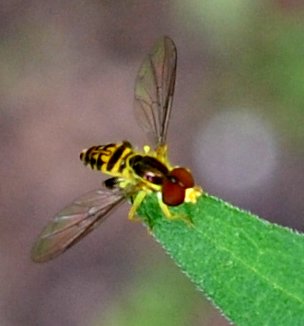
The long-legged flies with the bits of black in their wings always are about twice the size of the clear-winged one. I don't usually get these long-leggers in profile, but it really shows off their good old long legs.
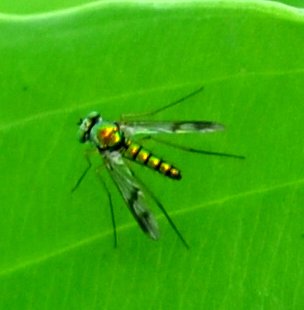
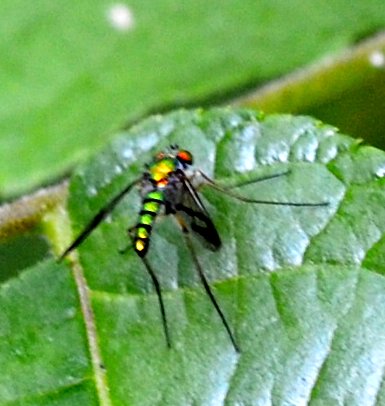
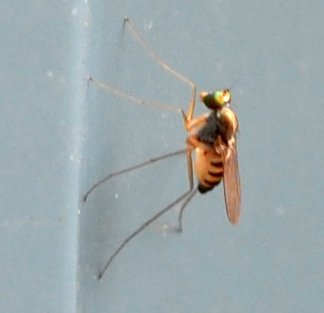
Don't you want to take an intermission and see some more flowers/plants? This is the view across the south back garden looking in towards the trumpetvines all over the house The bladder campion stays close to the shop wall. Finally! The lily of which you've seen a lot of its huge buds is now blooming. It had only three blossoms but it's getting stronger since I moved it out front.
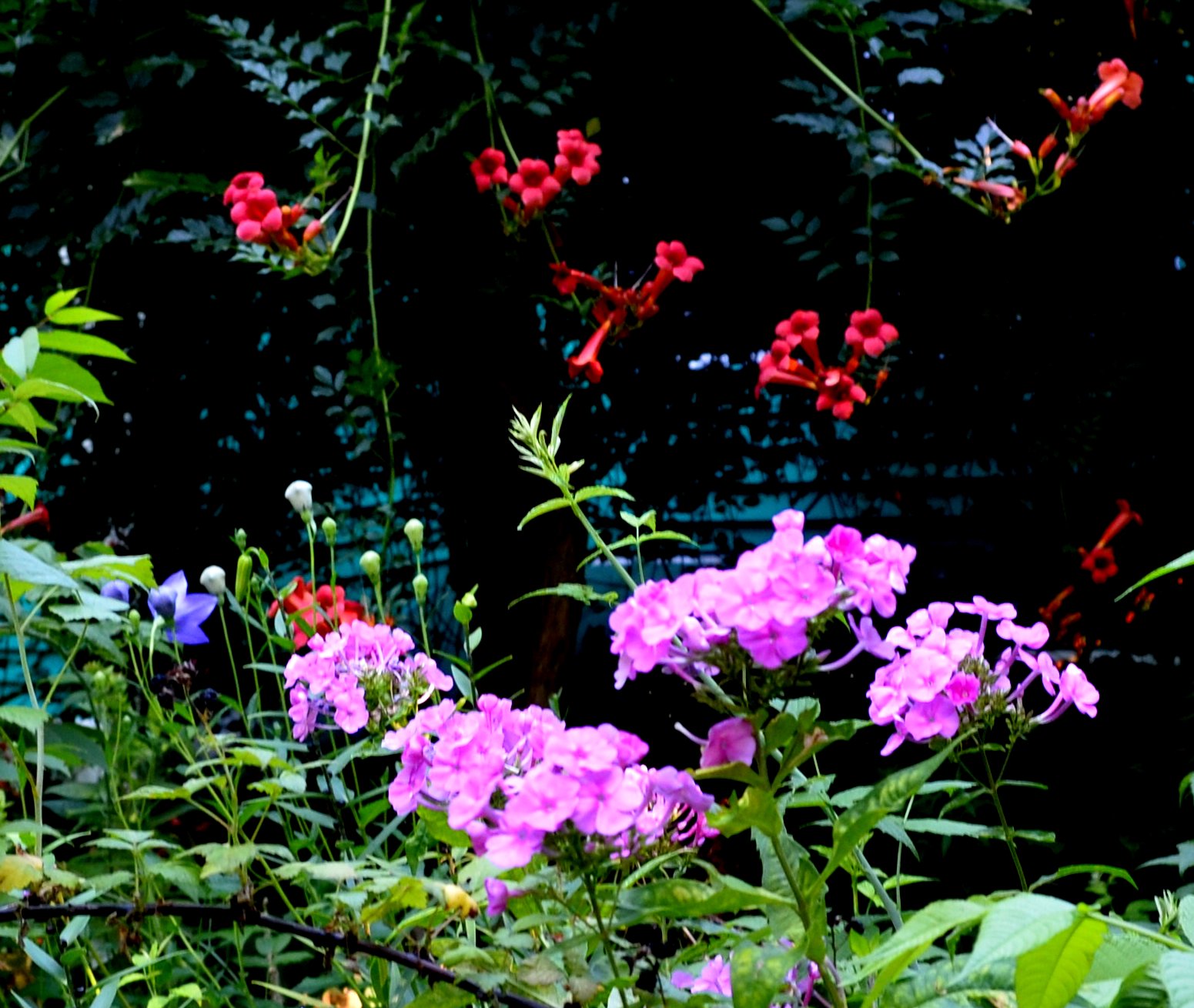
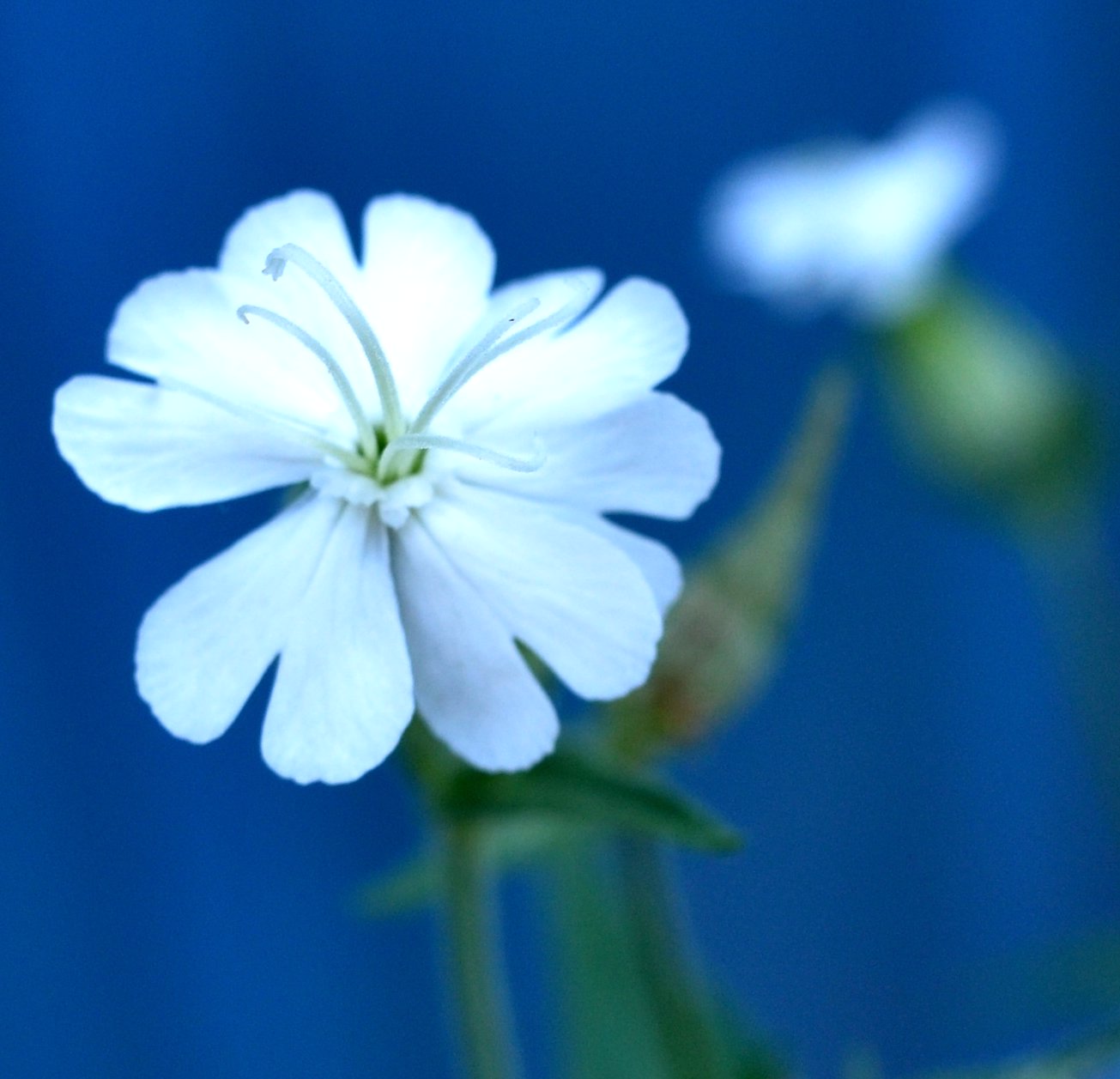
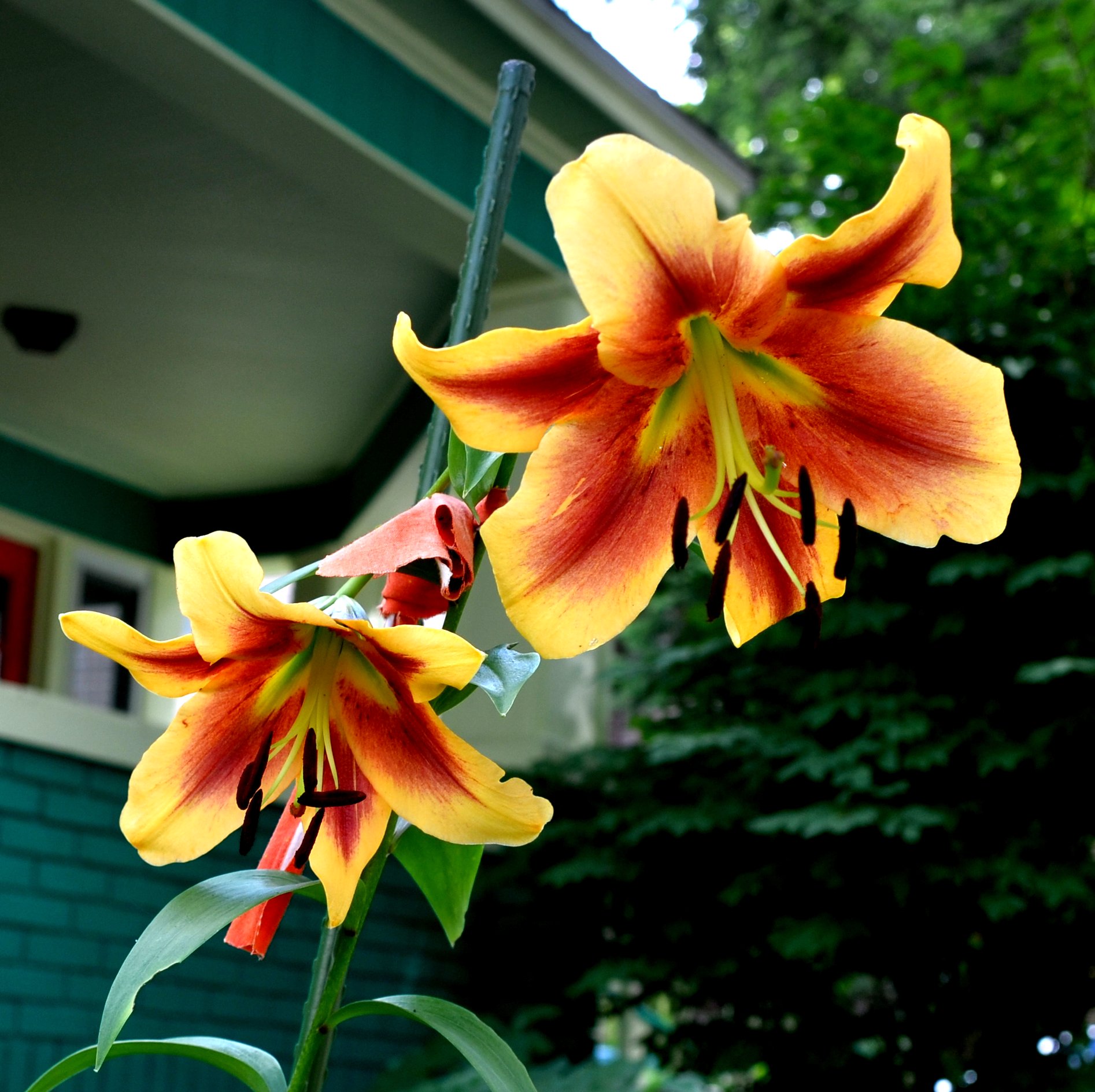
Here are a couple of flies with decorative wings. First is the so-called Picture Wing Fly. The second one is its relative, Rivellia colei and quadrifasciata.
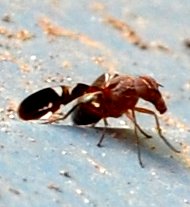
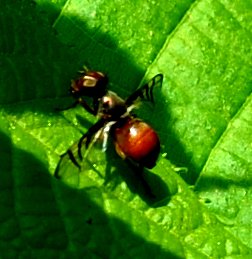
Here are a few of our harvestmen. I never realized how beautiful they can be!

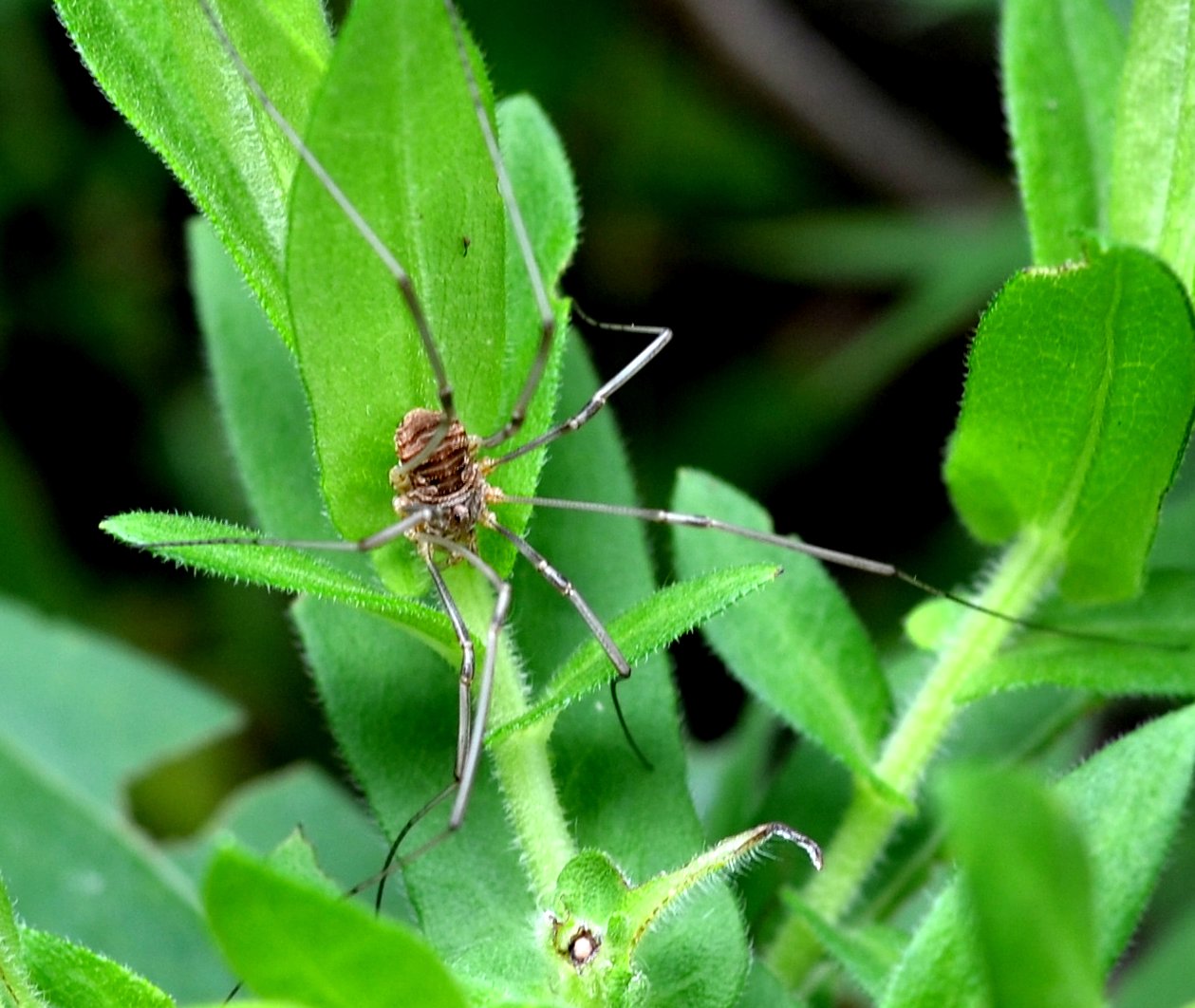
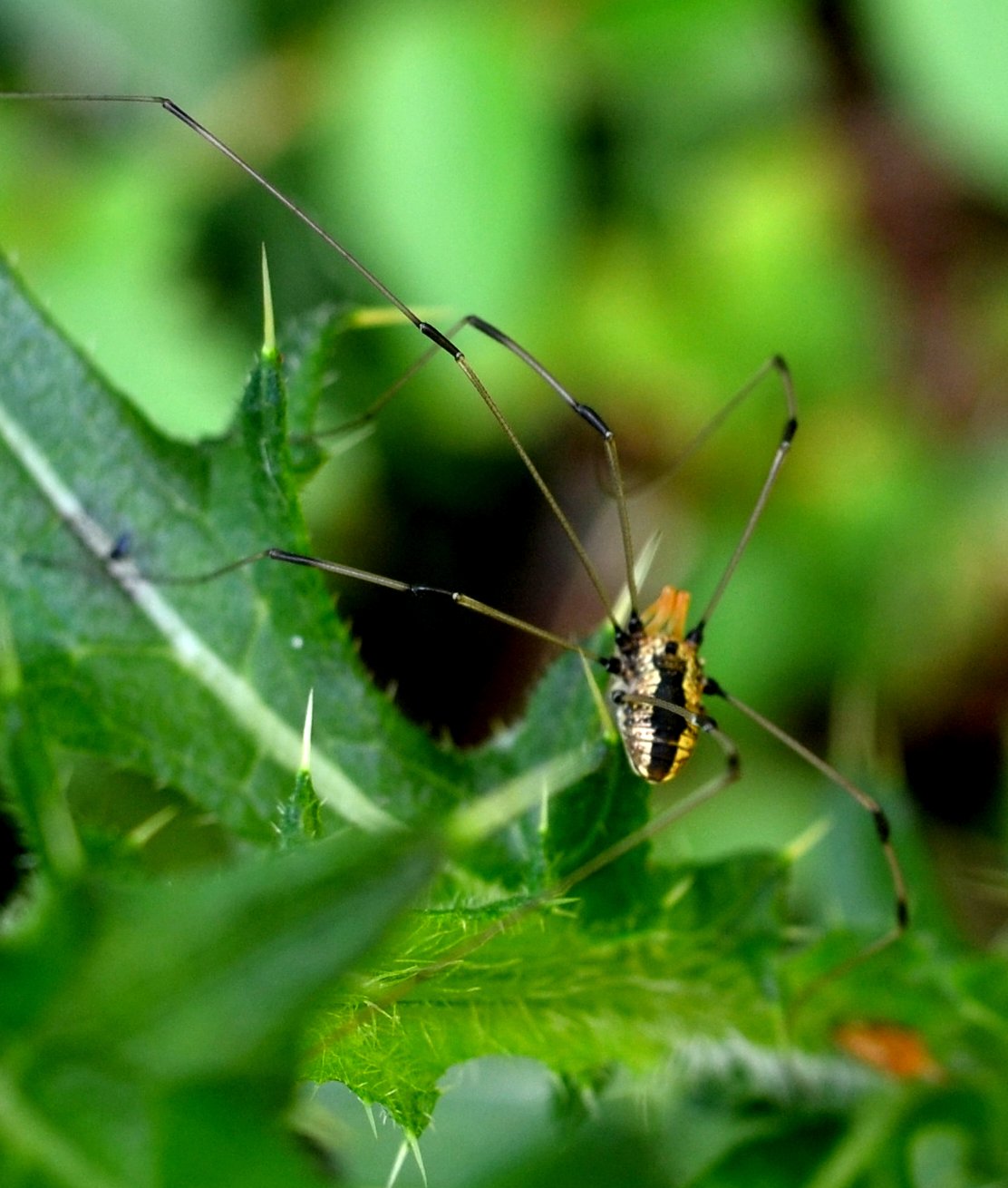
We had two very different mayflies last week. One, this very long one with distinctive markings of black; and the other, about a half-inch long, with very pale markings.
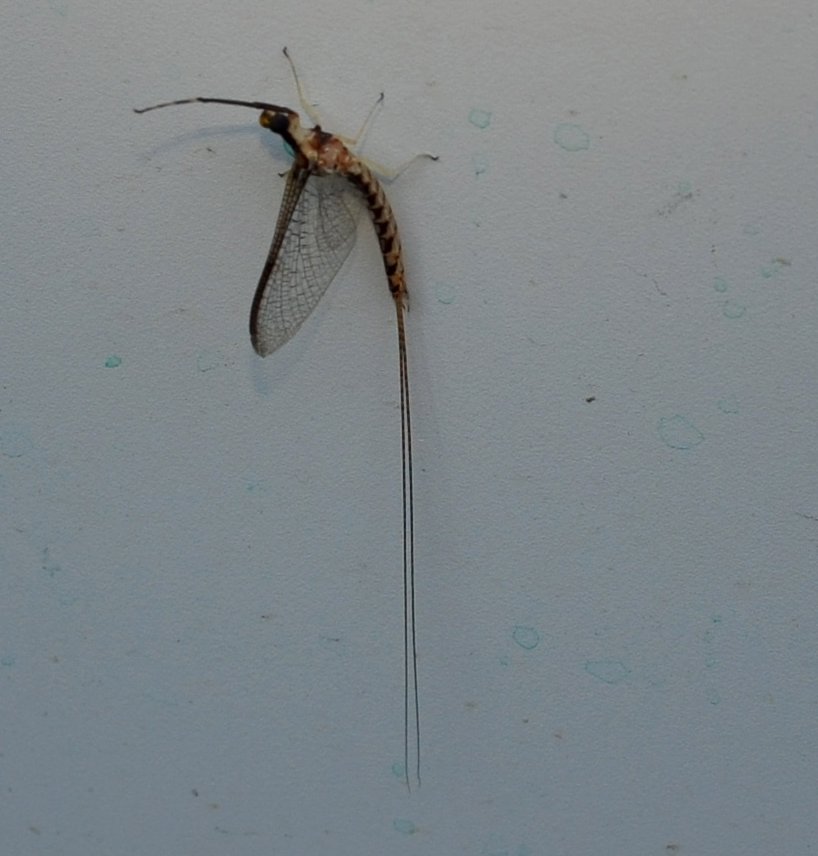
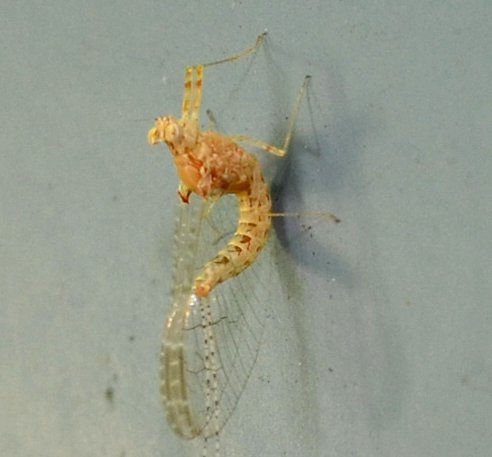
Among the Orthopterans, we had this little cricket, this sandstone grasshopper, and this locust that shows butterfly-like wings of black and yellow when it is flying, but lands looking like the stones around the pond.
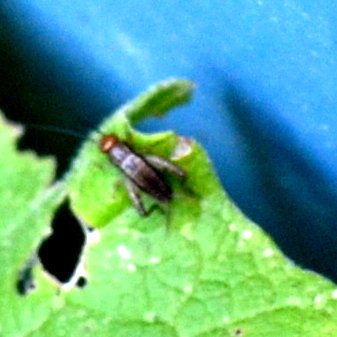
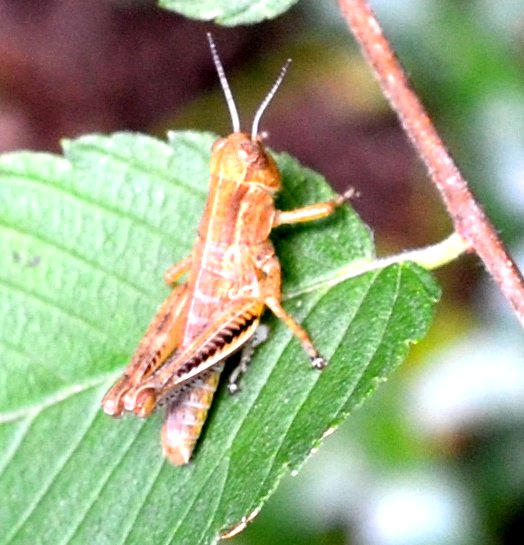
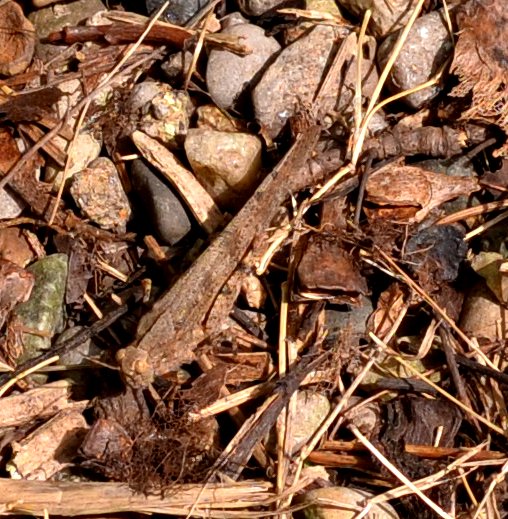
We've sailed past the zoo to the spider center. Here's a huge dark brown Common House Spider male. Then comes a cobweb spider from the shop door , and finally a nice egg sac with its spider hiding behind it.
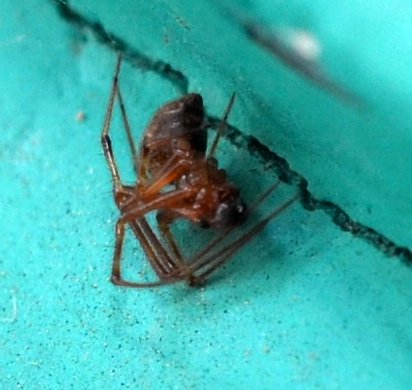
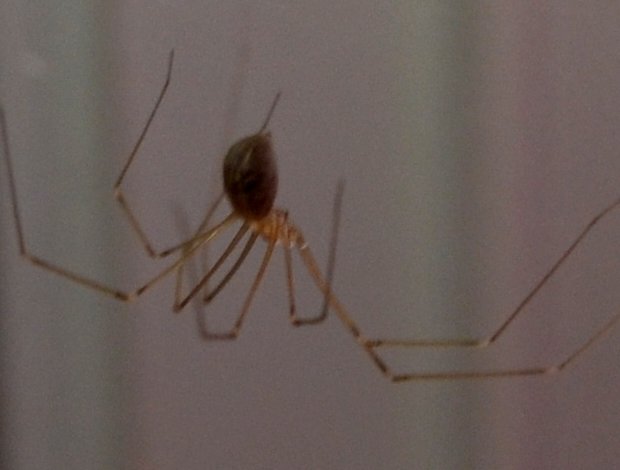
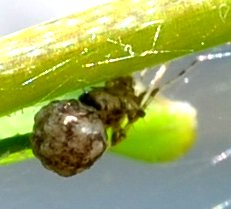
The other day, when I came in the back door from photographing the fauna out back, I was surprised almost to have walked into this spider's web. It is one of the orb-weavers, and probably the best way to prove that is to show you the nice round orb she seems to have made using a line from the ceiling and the back of a wicker chair. The orb shows up on the right of the picture. Fortunately I have a collection of jars and was able to pop her into one and walk 6 steps to the door. I put her gently onto the hisbiscus plant. At first she seemed a bit ill at ease, but then realized she was in her kind of territory.
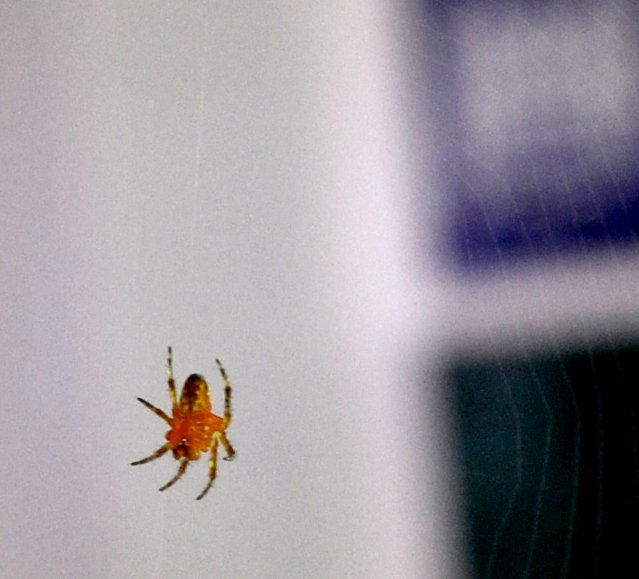
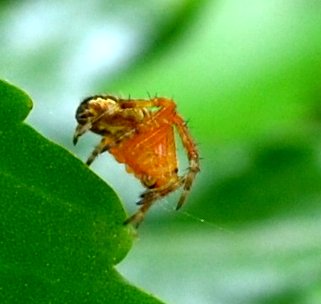
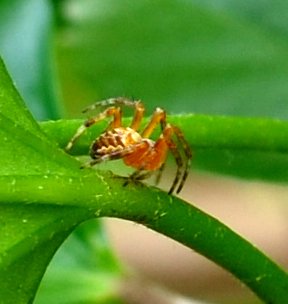
I think this is a chs male with a chs female, but the "female" doesn't look like most of the chs girls. In fact the second spider seems to have good-sized pedipalps. A bit later there was only the male chs. Here's one of our six-xpotted white spiders.
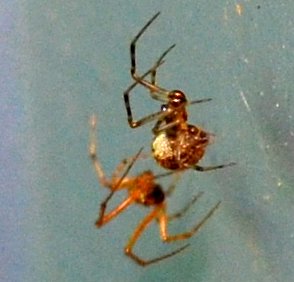
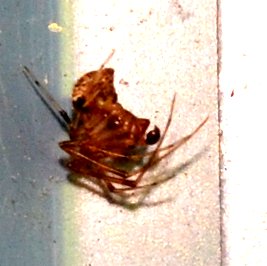
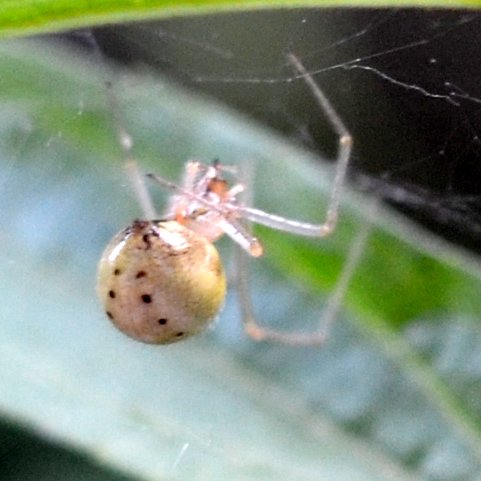
For some reason, the big wasps and yellowjackets haven't appeared yet. They used to have a good time in the trumpetvine, but the only big wasp (other than bees and other smaller wasps) I've spotted in the trumpets is the Great Black Wasp. There was a tiny wasp which is probably one of the Symmorphus potter wasp. And a very tiny waspy thing that (for some reason) got its fuzzy little picture taken just as as it was leaving. I did see a female Polistes briefly today, but no picture.
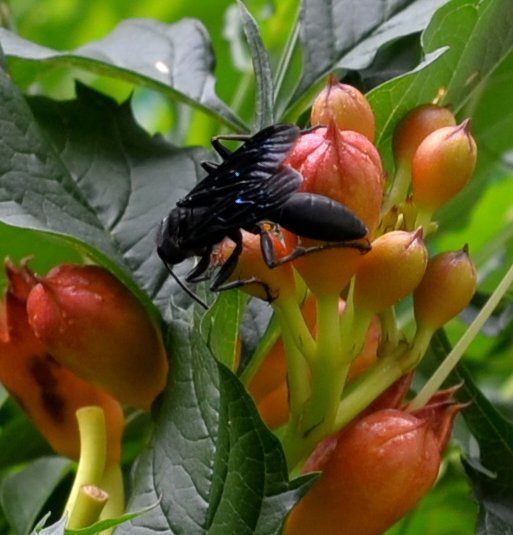
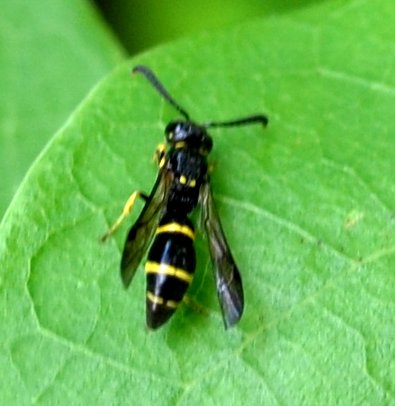
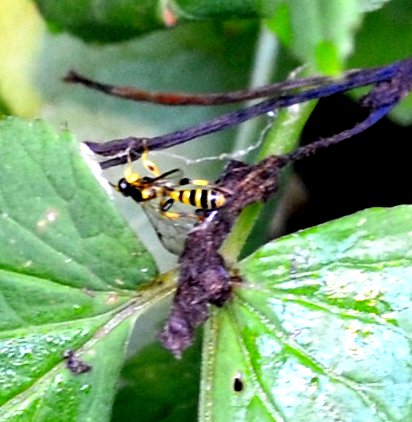
Did you worry that I would forget to show you the paper wasp nest? No worries! Here it is, roughly twice the size of last year's nest.

No more toad or frog pictures this week. However, I did almost manage to step on a tiny one or the other twice at some distance from the pond. So I'll just end with a few more of the prettier sights of the week. Here is the trumpetvine against the south side of the house. Then some more daylilies. The lemon-colored one was from John Kondelik's collection.
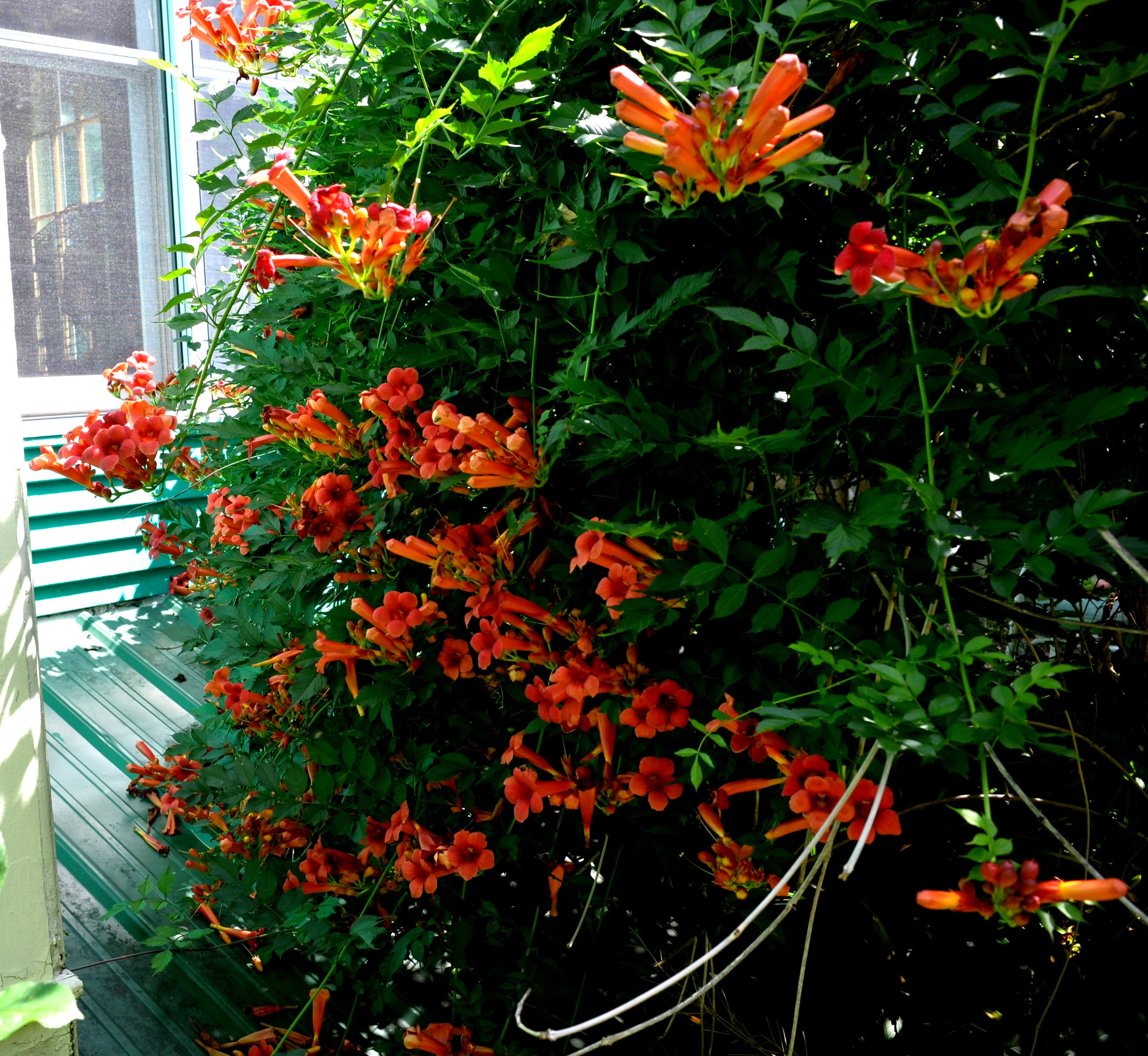
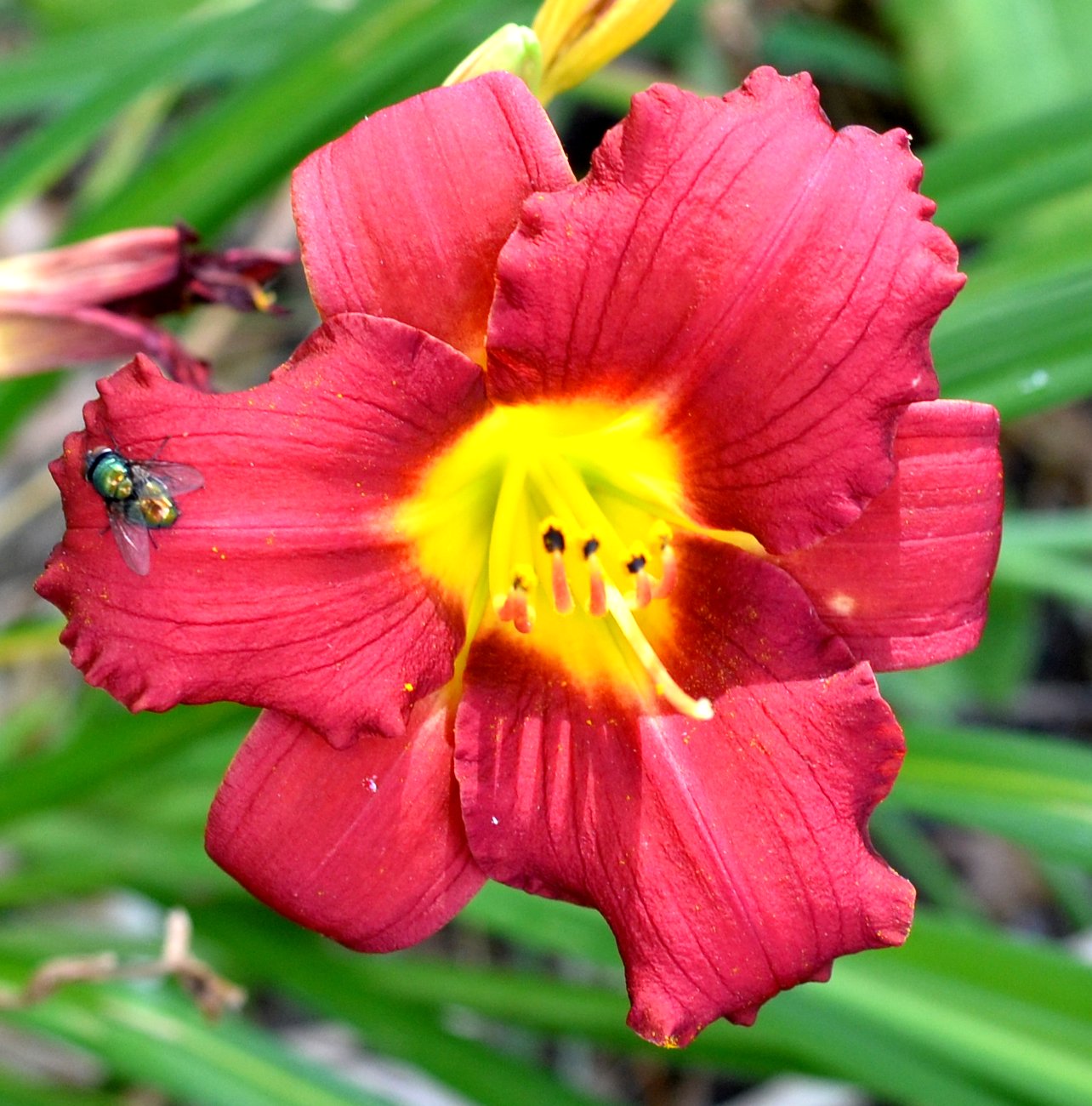
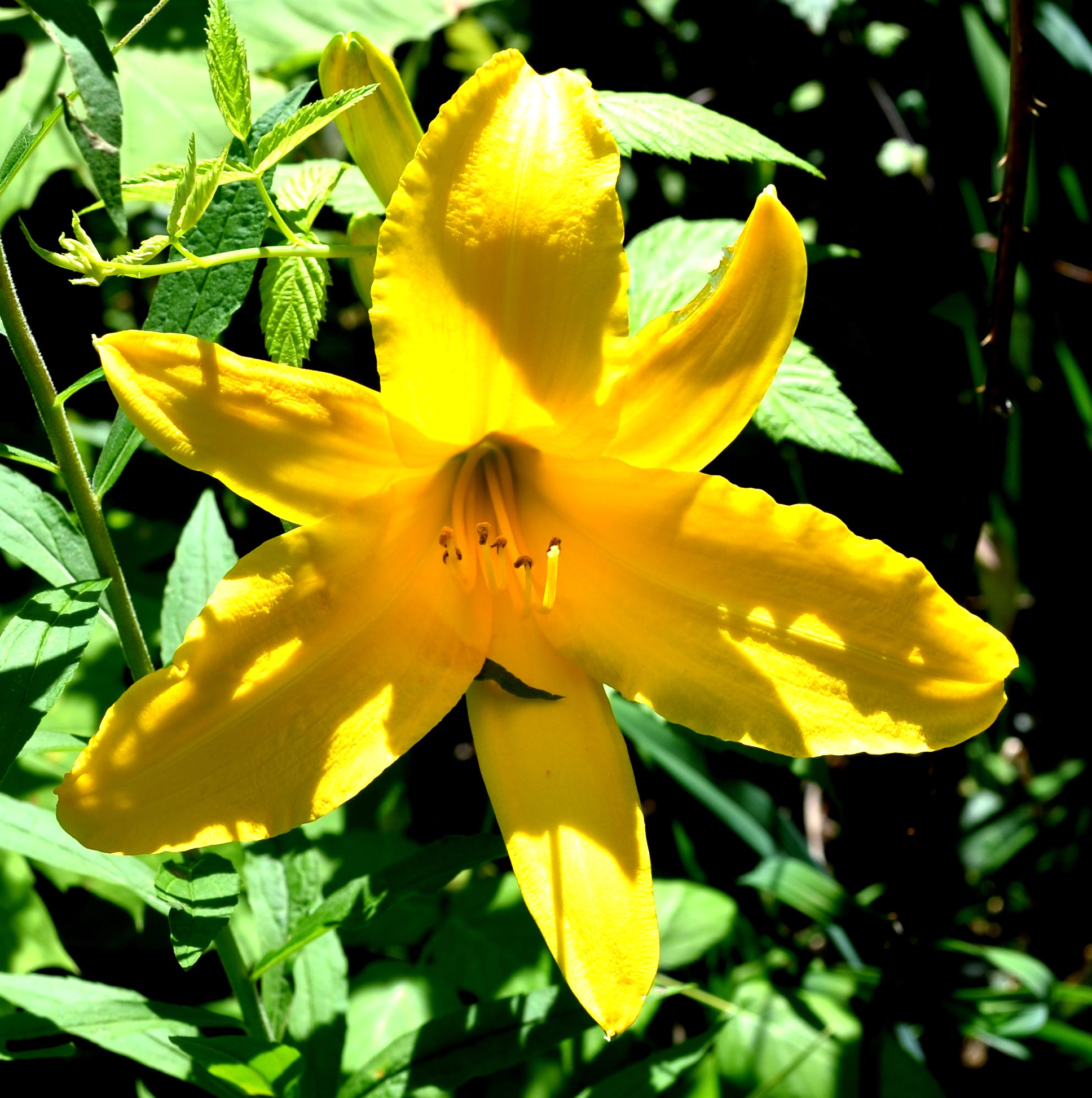
So the weeks go by quietly in this corner of the world. I keep busy signing petitions and writing emails to people who may or may not care about the things that they have some power to work on. Humans (except for you lot of course) are complicated animals. I won't say I prefer the company of wasps though. I hope there are some signs of sanity where you are, and that suddenly the world will wake up and get to work.
Back to July 10
On to July 24
Back to 2016 menu
Back to main menu
copyright Martha O'Kennon 2016









 .
.




 .
.































































